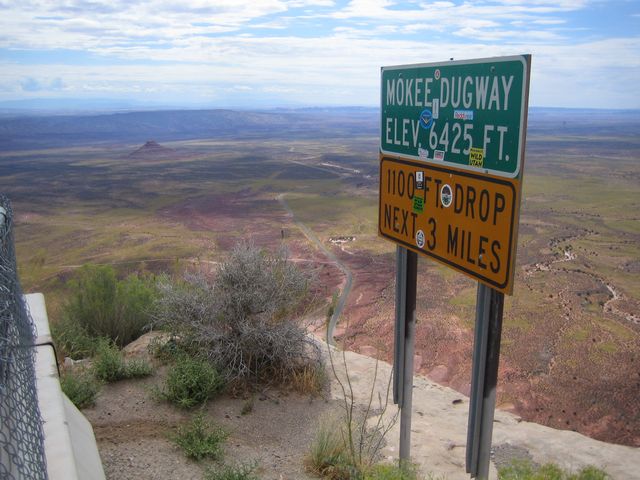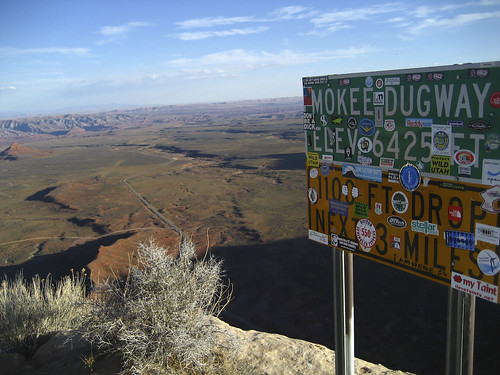Soon I was on Route 261. There was a warning sign at the beginning of it, "no trucks". I wondered why, because the road condition was quite good: it just meandered over the gently rolling terrain southward, in a lush forest of dwarf pinyon pines. The weather was good, sunny and breezy. At an altitude of 6500 ft, it was actually quite comfortable. There was very little traffic. I felt good driving on the lonely road.
Then about 20 miles out, I suddenly learned why: there was a huge drop in the road and it was unpaved. Coming to the edge of Cedar Mesa, Mokee (Moki) Dugway took over. In the next 3 miles, it made several switchbacks on the side of the cliff, dropping 1100 ft in its course. Down there in the Valley of the Gods, was a desert decorated with buttes and painted hills. A vista so open and broad, everyone had to stop and enjoy.
 Bell Butte in the foreground to the left, with Sugarloaf in the back.
Bell Butte in the foreground to the left, with Sugarloaf in the back. I saw this board on the side of the road with lots of colorful stickers. Quite interesting. I wondered why this board was there to begin with. Not for those stickers, I guess?
I saw this board on the side of the road with lots of colorful stickers. Quite interesting. I wondered why this board was there to begin with. Not for those stickers, I guess?
I only learned the answer today!
Makeover of a road sign:
Here is a picture of this board copied from http://www.midwestroads.com/otherstates/mokidugway/
 And another one on Flickr uploaded on Nov. 16, 2007 by Caddymob. Today was July 4, 2008. Go figure how fast it got covered up. I wonder how many people travel with stickers!
And another one on Flickr uploaded on Nov. 16, 2007 by Caddymob. Today was July 4, 2008. Go figure how fast it got covered up. I wonder how many people travel with stickers!
Last, this one (copied from http://www.imagesoftheworld.org/GrandCircle/mokidugway.html) seems to be the first photo of the road sign that I can find:
Looking to the south through mid-day haze, you can see Goosenecks in the foreground, and maybe Monument Valley in the background.
 Looking southeast. Part of the switchback can be seen.
Looking southeast. Part of the switchback can be seen. Looking east to northeast, Valley of Gods.
Looking east to northeast, Valley of Gods.
Route 316 off 261 brought us to Goosenecks State Park. Here San Juan River makes three 180-degree turns. The vista is so wide, I had to cover it with three shots with the widest angle. The following three shots were from left to right at Goosenecks. To see a good panoramic photo, click here.


 At the right side of the second Gooseneck, looking southwest, on the far horizon was Monument Valley.
At the right side of the second Gooseneck, looking southwest, on the far horizon was Monument Valley. Looking back northwest towards Cedar Mesa:
Looking back northwest towards Cedar Mesa: Looking northeast towards Sugarloaf:
Looking northeast towards Sugarloaf:
Last stop: Mexican Hat:



































